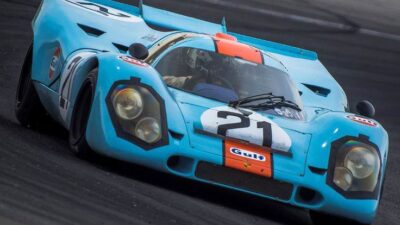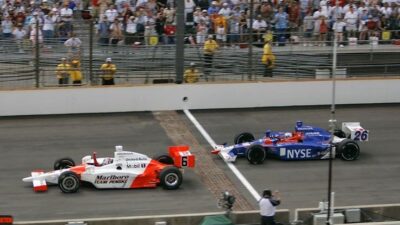Racing an endurance event like the 24 Hours of Le Mans or a NASCAR 600-mile race pushes drivers to their absolute limits. These marathons of motorsport can last anywhere from 6 to 24 hours, demanding peak physical and mental performance when fatigue sets in and mistakes become costly.
Endurance race drivers train like elite athletes, combining cardiovascular fitness, strength training, mental conditioning, and strategic preparation to maintain focus and performance throughout grueling multi-hour competitions. NASCAR drivers are training like endurance runners to build the stamina needed for these demanding events.
Modern endurance racing has evolved far beyond simply having fast reflexes. Drivers must withstand extreme G-forces, high cockpit temperatures, and intense mental pressure while making split-second decisions for hours on end. How drivers and teams prepare for an endurance race involves comprehensive physical and mental preparation that rivals any traditional sport.
Key Takeaways
- Endurance drivers focus on cardiovascular training like running and cycling to build stamina for races lasting up to 24 hours
- Physical preparation includes specific neck and core strengthening exercises to handle extreme G-forces throughout long races
- Mental conditioning and simulator training help drivers maintain focus and decision-making skills during high-stress situations over extended periods
Understanding Endurance Racing Demands
Endurance racing presents unique challenges that differ drastically from sprint racing formats like F1, requiring drivers to maintain peak performance over extended periods while adapting to constantly changing conditions. The physical and mental demands intensify as races stretch from 4 to 24 hours, with preparation beginning weeks in advance.
Unique Physical and Mental Challenges
Endurance racing demands test both vehicle durability and driver stamina in ways that traditional motorsport formats cannot match. Unlike F1 racing where drivers compete for 90-120 minutes, endurance drivers must perform for multiple hours at a time.
Physical Requirements:
- Drivers maintain approximately 8% body fat for optimal performance
- Extended driving sessions last 3-4 hours overnight
- Core strength and cardiovascular fitness become critical for sustained focus
The mental challenges prove equally demanding. Driver preparation involves extensive mental conditioning weeks before race day.
Drivers like Sally Mott train focus by playing high-intensity ping pong for 45 minutes daily. This matches typical shift lengths in endurance racing.
Mental Training Elements:
- Simulator practice for track memorization
- Video analysis of previous races
- Visualization of cornering and gear shifts
- Strategic planning for passing opportunities
Race conditions change dramatically throughout extended events. Drivers adapt to temperature variations, lighting changes from day to night, and evolving track conditions.
Key Endurance Racing Events
The triple crown of endurance racing consists of three premier events that define the sport’s highest level of competition.
Major Endurance Racing Series:
| Event | Duration | Series | Notable Features |
|---|---|---|---|
| 24 Hours of Le Mans | 24 hours | WEC | Most prestigious endurance race |
| Rolex 24 at Daytona | 24 hours | IMSA | Season opener with Rolex prizes |
| 12 Hours of Sebring | 12 hours | IMSA | Challenging track surface |
The WEC (World Endurance Championship) and IMSA feature various race lengths. Some events last 4-6 hours while others extend beyond 12 hours.
Race formats vary significantly from F1 Grand Prix events. Endurance races can span 6 to 24 hours compared to F1’s typical 90-minute format.
Teams use multiple drivers per car, typically 2-4 depending on race length. Driver rotations occur every 45-50 minutes in shorter events.
For 24-hour races, drivers often pull double shifts lasting several hours. This strategy reduces driver changes and potential complications.
Preparation Timeframes and Logistics
Teams arrive approximately two weeks early for major events like the Rolex 24 at Daytona to complete practice sessions and qualifying rounds.
Pre-Race Timeline:
- 2 weeks before: Team arrival and setup
- 1 week before: Driver obligations and practice
- Few days before: Pit area construction
- Race day: Final preparations and strategy meetings
Pit setup requires several days for major teams. Equipment includes specialized tools, spare parts, and monitoring systems for 24-hour operations.
Logistical Requirements:
- Large RVs for driver rest areas
- On-site chefs and trainers
- Simulator facilities for track practice
- Tire and fuel management systems
Pit crews face unique challenges during extended races. They must remain alert for pit stops every 40 minutes throughout the entire event.
Crew members work in shifts but cannot take extended breaks. Teams rebuild cars continuously while maintaining IMSA safety regulations.
Post-race teardown takes approximately one day. Teams then transport equipment to the next race venue within days.
Physical Training for Endurance Drivers
Endurance racing demands exceptional physical preparation across three critical areas. Drivers must build cardiovascular systems capable of sustaining elevated heart rates for hours, develop core and neck strength to handle intense G-forces, and condition their bodies to perform in extreme heat conditions.
Cardiovascular Endurance Development
F1 drivers engage in various endurance exercises to build the cardiovascular fitness required for long races. Their heart rates can reach 150-170 beats per minute during competition.
Running forms the foundation of most drivers’ cardio programs. Long-distance runs build the base endurance needed for multi-hour races.
Cycling provides low-impact cardiovascular training while strengthening leg muscles. Many drivers use stationary bikes in hot environments to simulate race conditions.
High-intensity interval training (HIIT) mimics the demands of racing. Drivers alternate between intense bursts and recovery periods to match race pace variations.
Swimming offers full-body cardiovascular conditioning without joint stress. It also helps build the breathing control needed in racing helmets.
Formula 1 drivers include running, cycling, and swimming in their regular training routines to build stamina and cardiovascular endurance.
Core and Neck Strength Training
Core strength provides the stability drivers need to maintain precise control under extreme forces. A strong core also reduces fatigue during long stints.
Planks and their variations build isometric core strength. Drivers hold these positions for extended periods to match race duration demands.
Medicine ball rotations simulate steering motions while strengthening the core. Side-to-side medicine ball rotations help develop the rotational strength needed for quick direction changes.
Neck training is critical for handling G-forces that can reach 4G in some corners. Shifter karting provides excellent neck training while working other body areas simultaneously.
Resistance band exercises target neck muscles specifically. Drivers use bands to create lateral tension for 4-5 seconds, mimicking race conditions.
TRX suspension training adds instability to core exercises. This equipment helps drivers develop the stabilization skills needed in racing cockpits.
Heat Acclimation Strategies
Cockpit temperatures can reach 30-40 degrees warmer than outside air. Drivers can lose up to 7 pounds through sweating during a three-hour race.
Training for heat acclimation involves cycling and running in environments similar to race conditions. This prepares the body’s cooling systems for extreme temperatures.
Sauna training helps drivers adapt to sustained heat exposure. Regular sauna sessions improve the body’s ability to regulate temperature efficiently.
Hot yoga combines flexibility training with heat conditioning. The controlled environment allows drivers to practice maintaining focus in uncomfortable temperatures.
Indoor cycling in heated rooms simulates cockpit conditions while building cardiovascular fitness. Trainers often set temperatures to match expected race day conditions.
Hydration protocols become crucial during heat training. Drivers learn to optimize fluid intake timing and composition for maximum performance in hot conditions.
Simulators and Real-World Practice
Modern endurance racing combines high-tech simulator training programs with detailed track analysis to prepare drivers for races lasting 6 to 24 hours. Professional teams use these tools to maximize limited real-world practice time while building the mental stamina needed for marathon racing sessions.
Simulator-Based Training Programs
Professional racing teams now rely on advanced simulators to replicate race conditions with remarkable accuracy. These systems recreate tire wear patterns, fuel consumption, and changing track temperatures that drivers face during actual endurance events.
F1 drivers like Max Verstappen regularly use simulators to maintain race sharpness between events. The same technology benefits WEC competitors who must adapt to multiple track surfaces and weather changes during 24-hour races.
Simulators allow drivers to practice for extended periods, building the physical and mental endurance required for long stints. Teams program specific scenarios like night driving, rain conditions, and traffic management that occur during endurance races.
The technology integrates real telemetry data from previous races. This allows drivers to experience exact car behavior and setup changes before arriving at the track.
Key simulator training elements:
- Stint length practice – 2-4 hour sessions
- Weather condition simulation – Rain, fog, temperature changes
- Traffic scenarios – Lapping slower cars, defensive driving
- Night driving preparation – Reduced visibility conditions
Track Study and Analysis
Endurance racing demands intimate knowledge of track layouts that span multiple configurations and surface types. Drivers study Formula 1 circuits like Spa-Francorchamps and specialized endurance venues like Le Mans using detailed video analysis and data overlays.
Teams break down each corner’s characteristics during different times of day. Track conditions change dramatically over 12 or 24-hour periods as rubber buildup, temperature, and grip levels fluctuate.
Professional drivers use simulators to learn new circuits before ever turning a real lap. This virtual practice saves valuable testing time and reduces the learning curve during actual practice sessions.
WEC events require drivers to master multiple track variants and pit lane procedures. They study fuel consumption maps, tire degradation patterns, and optimal racing lines for different car configurations.
Essential track study components:
- Corner analysis – Entry speeds, apex points, exit strategies
- Reference points – Braking markers, turn-in cues
- Elevation changes – Blind corners, crests, compressions
- Surface variations – Grip levels, bump locations
Nutrition, Hydration, and Recovery
Racing drivers require specific fuel for their bodies just like their cars need precise fuel mixtures. Proper nutrition timing, targeted hydration strategies, and systematic recovery methods help drivers maintain peak performance during grueling multi-hour races.
Personalized Nutrition Plans
Each driver needs a unique nutrition approach based on their body size, racing schedule, and training intensity. Race drivers training seven days a week need slow-acting carbohydrates like pasta or brown rice to fuel both circuit workouts and endurance sessions.
Pre-Race Nutrition Timeline:
- 3 hours before: 2-3g carbs per kg body weight
- 1 hour before: Light snack with simple carbs
- During race: 30-60g carbs per hour for races over 60 minutes
Drivers often work with sports nutritionists to create meal plans that account for race schedules across different time zones. Lewis Hamilton follows a plant-based diet that he credits for improved recovery and sustained energy levels.
The pit crew also follows structured nutrition plans since their quick reflexes and strength directly impact race outcomes. They eat easily digestible foods before races to avoid sluggishness during critical pit stops.
Hydration Techniques
Cockpit temperatures can reach 140°F, making hydration critical for driver safety and performance. Most drivers lose 3-8 pounds of fluid during a single race through sweat.
Hydration Strategy:
- Pre-race: 16-20 oz fluid 2-3 hours before
- During race: 4-6 oz every 15-20 minutes via drink tube
- Post-race: 150% of fluid lost through sweat
Drivers customize their drink mixtures with electrolytes and carbohydrates. The exact formula varies by driver preference and race conditions.
Heat acclimatization training helps drivers adapt to extreme cockpit temperatures. They practice in heated environments to improve their body’s cooling efficiency and reduce fluid loss rates.
Recovery Methods After Training and Races
Recovery starts immediately after climbing out of the car. Drivers consume carbohydrates and protein within 30-60 minutes post-exercise to replenish glycogen stores and promote muscle repair.
Recovery Protocol:
- Immediate (0-30 min): Rehydration and carb-protein snack
- Short-term (1-4 hours): Full meal with anti-inflammatory foods
- Long-term (24-48 hours): Sleep optimization and light movement
Drivers use ice baths, compression garments, and massage therapy to reduce muscle inflammation. Sleep becomes the most important recovery tool, with many drivers using sleep coaches to optimize rest quality.
Active recovery includes light swimming or cycling on rest days. This promotes blood flow without adding training stress before the next race weekend.
Frequently Asked Questions
Drivers face unique challenges when preparing for endurance races that require specialized training approaches. The preparation involves specific physical conditioning routines, mental training techniques, carefully planned nutrition strategies, realistic simulation methods, proper rest protocols, and structured pathways for skill development.
What physical conditioning programs do drivers typically follow to prepare for endurance races?
Drivers engage in intensive cardio workouts, strength training, and flexibility exercises to build the stamina needed for long races. The physical demands of controlling a race car for hours require targeted fitness programs.
Cardiovascular training forms the foundation of driver conditioning. Runners and cyclists often cross-train because these activities build the endurance needed for extended periods behind the wheel.
Strength training focuses on core muscles, neck, and arms. These muscle groups handle the G-forces and steering demands during long stints on track.
Heat tolerance training helps drivers cope with cockpit temperatures. Drivers practice in hot environments to prepare their bodies for race conditions.
Due to the physical demands, drivers commonly cross-train in endurance sports such as cycling or running. This approach builds the cardiovascular base essential for maintaining focus during races.
How do drivers mentally prepare for the physical and mental stresses of endurance racing?
Mental preparation includes visualization techniques and focus exercises. Drivers practice staying alert and making quick decisions over extended periods.
Concentration training helps drivers maintain attention during long races. They practice filtering out distractions while processing important information from the track and team.
Stress management techniques teach drivers to handle pressure situations. These skills become critical during close racing or when mechanical issues arise.
Sleep pattern adjustment helps drivers prepare for races at different times. Some endurance races run through the night, requiring altered sleep schedules.
Team communication practice ensures clear radio conversations. Drivers train to give and receive information quickly and accurately during races.
What specific nutrition plans do drivers adhere to during the race season?
Hydration strategies prevent dehydration during long stints. Drivers consume electrolyte drinks before, during, and after track sessions.
Pre-race meals focus on complex carbohydrates for sustained energy. Drivers avoid foods that might cause stomach issues during competition.
In-car nutrition includes easy-to-consume energy sources. Drink tubes and energy gels provide fuel without requiring complex movements.
Post-session recovery nutrition helps muscles repair and rebuild. Protein and carbohydrates consumed within 30 minutes optimize recovery.
Weight management becomes important for car performance. Drivers maintain optimal body weight while preserving muscle strength and endurance.
How do racing teams simulate race conditions during training sessions?
Simulating racing conditions is a vital part of preparation. Teams create long practice sessions that mirror actual race scenarios.
Extended practice sessions build driver stamina gradually. These sessions increase in length as race day approaches.
Variable weather training prepares drivers for changing conditions. Teams practice in different temperatures, rain, and wind conditions.
Night driving practice becomes essential for 24-hour races. Drivers adapt their vision and reaction times to low-light conditions.
Driver rotation practice ensures smooth handovers. Teams rehearse the timing and communication needed for driver changes.
Equipment testing during long sessions identifies potential problems. Teams discover issues that only appear after extended use.
What role does sleep and rest play in a driver’s preparation for an endurance event?
Sleep quality directly affects reaction times and decision-making abilities. Drivers prioritize consistent sleep schedules during training periods.
Recovery time between training sessions prevents overexertion. Proper rest allows the body to adapt to increased training demands.
Pre-race rest strategies optimize alertness for competition. Drivers adjust their sleep patterns days before major events.
Power napping techniques help during multi-driver races. Drivers learn to rest effectively during their off-track periods.
Sleep environment optimization improves rest quality. Drivers create consistent conditions for better sleep at different race locations.
How do novices transition to professional level in endurance racing?
If you live in the eastern half of the country, you could practically get to an enduro within a 6-hour drive nearly 40 weekends a year. This accessibility helps new drivers gain experience quickly.
Entry-level endurance series provide stepping stones to professional racing. Drivers start with shorter races and progress to longer events.
Mentorship programs pair novices with experienced drivers. These relationships provide practical knowledge and racing opportunities.
Simulator training helps new drivers learn tracks and techniques. Modern simulators offer realistic preparation without track costs.
Physical fitness development begins early in a driver’s career. Young drivers build endurance capabilities through consistent training programs.
Budget management skills become essential for career progression. Drivers learn to secure sponsorship and manage racing expenses effectively.









